
Weekly Economic Outlook – US inflation and Chinese data in focus.
This week’s global economic spotlight falls on the U.S. inflation report and China’s key activity data; both set to shape market sentiment and central bank expectations. Investors will watch for signs of easing price pressures in the U.S. and fresh clues on China’s growth momentum heading into Q4.
USA
The U.S. economy is still expanding, but at a slower, more sustainable pace. Resilient consumers, disciplined fiscal management, and solid corporate performance remain strengths—but prolonged political uncertainty or inflation surprises could unsettle the recovery.
U.S. Economic Summary — Mid-October 2025
The outlook for the U.S. economy in the coming weeks hinges on two critical factors: the duration of the federal government shutdown and the trajectory of inflation once data collection resumes. For now, the economy continues to show resilience despite headwinds, with steady consumer spending, cautious business investment, and moderate inflation shaping a picture of slowing but stable growth.
If the shutdown ends soon and normal data flow returns, growth could settle near its long-term trend. However, a prolonged disruption risks eroding confidence at a delicate time—when momentum is already softening and price pressures remain sticky.
Resilience Amid Uncertainty
The shutdown, now stretching into its third week, has delayed key economic reports, leaving policymakers and analysts to work with partial visibility. Despite limited data, available indicators point to an economy that is holding steady but losing speed. Consumer spending remains firm, manufacturing shows tentative stabilization, and housing activity is improving slightly as mortgage rates ease.
The U.S. remains anchored by solid fiscal fundamentals and strong corporate balance sheets. Yet, uncertainty surrounding government operations, tariffs, and inflation trends could restrain optimism heading into the year’s final quarter.
Fiscal & Financial Stability
September’s fiscal data surprised on the upside. The Federal Budget Balance swung to a $198 billion surplus, reversing August’s $345 billion deficit—the first surplus in six months. This improvement reflects robust tax inflows and lower end-of-year spending, signaling that fiscal discipline persists despite political gridlock.
The Federal Reserve’s balance sheet held steady near $6.6 trillion, while bank reserves edged slightly lower to $2.99 trillion. Liquidity conditions remain comfortable, with no signs of financial stress. Together, these factors reinforce the perception of a stable macroeconomic foundation, even as interest rates stay high.
Business, Housing & Industry
Small business optimism slipped, with the NFIB Index falling to 98.8 amid uncertainty about policy and demand. Manufacturing indicators such as the Philadelphia Fed Index turned negative, though core components—like new orders and capital spending—remain stable. Meanwhile, corporate earnings have provided reassurance: major banks (JPMorgan, Citi, Goldman Sachs, BofA) all beat estimates, underscoring strong credit demand and profitability.
The housing market is showing early signs of recovery. The NAHB Index rose to 37 in October, supported by a drop in mortgage rates to around 6.3%. Though still well below pre-pandemic averages, improving affordability is encouraging modest buyer interest.
Inflation & Consumers
While the September CPI has been delayed until October 24, underlying indicators point to “sticky but stable” inflation. Wage growth is easing gradually, and energy prices have softened. Consumers continue to drive growth—spending robustly across travel, leisure, and services—supported by a strong labor market and healthy household finances.
U.S. Economic Outlook — Week 43, 2025 (October 20–26)
Economic visibility remains limited as the federal government shutdown enters its third week, leaving analysts and policymakers navigating without key data. The September Consumer Price Index (CPI)—granted a special release to calculate Social Security cost-of-living adjustments—will be the only major federal report this week, arriving on Friday, October 24. With Federal Reserve officials in their pre-meeting blackout period (October 18–30), market reactions to each data point will likely be more pronounced. Overall, the economy remains resilient but gradually moderating, while inflation appears stuck near 3%, keeping the Fed cautious ahead of its October 28–29 FOMC meeting.
Key Data & Events
The week begins quietly with the Conference Board’s Leading Economic Index (LEI) on Monday, October 20, one of the few uninterrupted indicators amid the data blackout. It is expected to show further late-Q3 cooling, consistent with softer momentum in manufacturing, investment, and consumer spending.
On Thursday, October 23, Initial Jobless Claims will be closely watched—if published. Private trackers indicate claims remain around 220,000, a level suggesting stable labor conditions, though any sustained increase would point to slower hiring momentum. The same day, Existing Home Sales will offer insight into how far lower mortgage rates are supporting resale demand after a year of affordability pressures.
Friday, October 24, marks a “data cluster day” with several crucial releases:
- CPI (September): The focal point for markets. Analysts expect headline inflation up 0.4% m/m and core up 0.3%, keeping both annual rates near 3.1%, the highest in over a year—implying stalled disinflation.
- S&P Global Flash PMIs: The first snapshot of Q4 business activity, gauging whether services strength continues to offset industrial softness.
- University of Michigan Consumer Sentiment (final, October): Key focus on inflation expectations at one- and five-year horizons.
- New Home Sales (September): A test of whether easing mortgage rates (~6.3%) and builder incentives are translating into higher closings.
Sector Insights
Housing: Resale activity remains about 25% below pre-pandemic norms, constrained by high prices and insurance costs. Mortgage rates have eased roughly 50 basis points since mid-summer, helping affordability modestly. Economists expect a 2.75% increase in September sales to 4.11 million (annualized)—still subdued but likely the best since February.
Inflation: While August’s data showed annualized inflation near 2.9% headline and 3.1% core, the expected September print suggests price pressures remain “sticky but stable.” The persistence of elevated services inflation will give the Fed little confidence that price normalization is complete.
USD and Wall Street Weekly Outlook — October 20–26, 2025
The coming week will be pivotal for both the U.S. dollar and Wall Street, as investors brace for two high-impact data releases: the delayed September CPI report and the S&P Global Flash PMIs. Together, these will set the tone ahead of the October 28–29 FOMC meeting, determining whether the Fed will justify a precautionary rate cut or keep policy unchanged.
The broader economic narrative remains one of resilience tempered by caution. Growth indicators show a steady yet moderate economy, while the ongoing federal shutdown has clouded visibility on recent performance. Investors are thus trading in an information vacuum, making markets hypersensitive to every macro release.
Market Sentiment and Conditions
Credit and labor signals continue to point toward a “soft patch, not a hard landing.” Jobless claims remain around 220,000—indicating stable labor conditions—while PMI readings hovering near 50 reflect an economy that’s stabilizing rather than contracting. Credit spreads are tight, but a hotter CPI could widen them as risk appetite cools.
With the Fed in its pre-meeting blackout, markets will receive no policy guidance, leaving CPI and PMI data as the key catalysts. Traders are taking a tactical stance, not a directional one: front-end Treasury yields are expected to consolidate near recent highs, while the U.S. dollar stays supported unless inflation shows meaningful cooling. Equities may open the week defensively, with investors favoring quality growth and dividend names before rotating into cyclicals if disinflation appears intact.
USD Outlook
Friday’s CPI report will be the decisive driver for the dollar. A soft print (headline ≤0.3% m/m) paired with weaker PMIs could lower yields and pressure the greenback, while a sticky outcome (headline ~0.4%, core 0.3%) would reinforce a wait-and-see Fed stance, supporting USD strength—particularly versus the euro and yen. A hot print (headline ≥0.5%) would push rate-cut expectations further out and spark fresh dollar buying.
Technically, the Dollar Index (DXY) trades sideways with a bullish bias, supported at 98.0 and targeting 99.0–99.8, with an extension toward 101.0 possible if momentum firms.
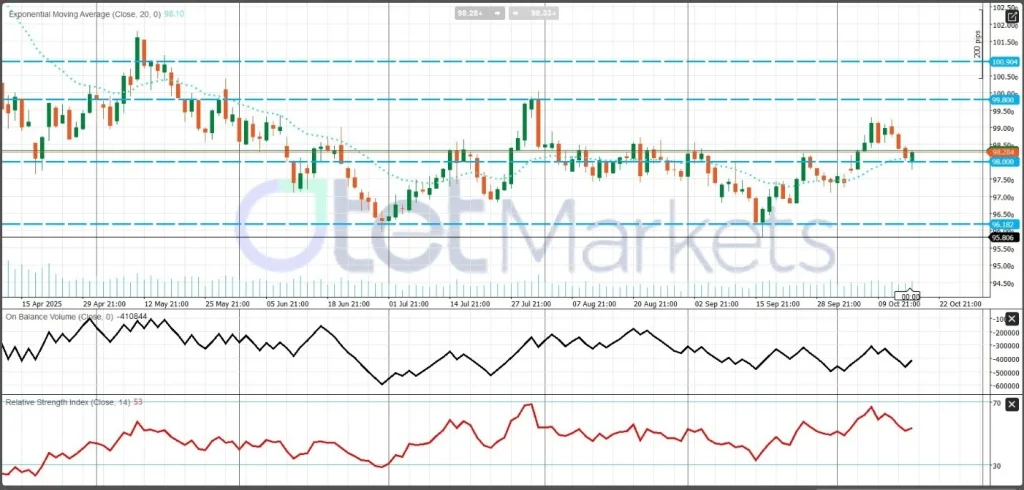
Wall Street Outlook
U.S. equities remain cautious but resilient. A modest rebound in existing home sales (expected +2.75%) and steady PMIs could lift cyclicals—industrials, materials, and financials—while a stronger CPI could rotate leadership back to defensives and large-cap tech. The ongoing earnings season continues to bolster sentiment, led by strong results in financials and tech.
The S&P 500 holds firm within its demand zone, supported near 6,500 with resistance around 6,700. A breakout above this range could reignite optimism heading into November.
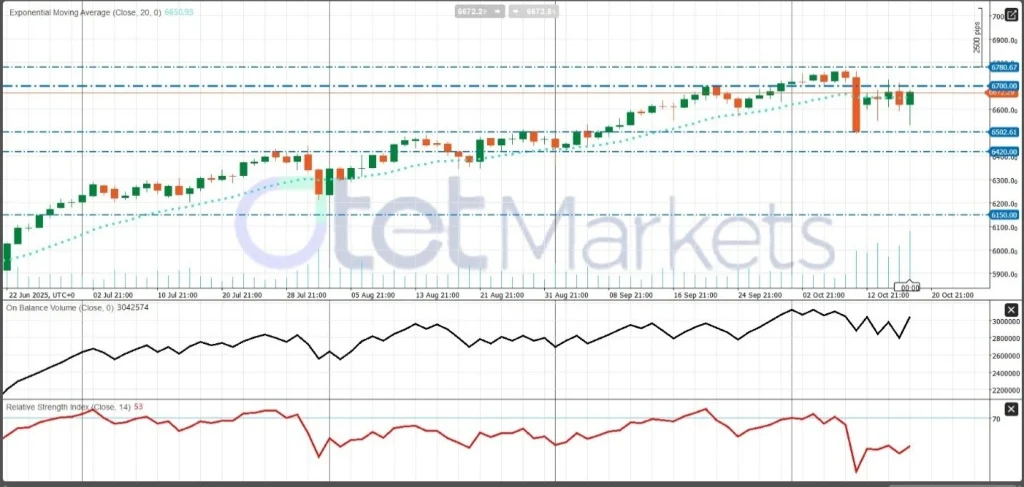
Corporate Earnings Review — Q3 2025
The third-quarter 2025 U.S. earnings season has begun on a strong and confident note, with major financial and technology firms delivering results that exceeded expectations. Despite higher interest rates, global uncertainty, and moderating economic growth, corporate America continues to prove its resilience. Solid consumer spending, active capital markets, and disciplined cost management have fueled better-than-expected results across most sectors, signaling that U.S. corporations remain fundamentally healthy heading into the year’s final quarter.
Financial Sector: Strong Foundation and Stability
America’s largest banks kicked off the season with impressive performances. JPMorgan Chase, Citigroup, and Bank of America all reported stronger-than-expected profits, supported by healthy loan growth, strong consumer credit, and stable net interest margins. Investment banks Goldman Sachs and Morgan Stanley benefited from a recovery in dealmaking and wealth management, while Wells Fargo improved profitability through cost controls. Asset managers and custodians also posted solid results—Charles Schwab, BNY Mellon, and BlackRock all saw expanding assets under management and trading activity. The lone weak spot came from Progressive, which missed estimates due to higher claims costs despite strong premium growth.
Overall, the financial sector remains well-capitalized, with strong credit quality and steady consumer activity offsetting mild margin pressure. This stability has set a positive tone for the broader earnings season, reinforcing confidence in the U.S. financial system amid a high-rate environment.
Corporate and Industrial Performance: Consumers and Tech Drive Growth
Beyond banking, consumer-facing and tech firms continued to shine. American Express reported record travel and entertainment spending among affluent clients, while Domino’s Pizza saw higher U.S. sales and faster international expansion. In transport, United Airlines posted strong profits despite elevated fuel costs, reflecting persistent travel demand.
In manufacturing and technology, ASML and TSMC delivered standout results, supported by surging demand for AI-related semiconductors and stable order books. Interactive Brokers also benefited from market volatility, with trading volumes hitting multi-quarter highs.
Together, these results highlight robust consumer spending and tech momentum, suggesting that both household demand and industrial activity remain firm even amid higher borrowing costs.
Key Takeaways and Market Reaction
- Financials lead to the recovery, with resilient profits and stable credit conditions.
- Consumers remain solid, sustaining travel, dining, and entertainment spending.
- Technology continues to outperform, powered by AI and semiconductor demand.
- Margins are well managed, showing cost discipline despite inflation.
- Earnings quality remains high, with most firms beating both EPS and revenue forecasts.
Equity markets have responded positively, led by financials and tech. The S&P 500’s Q3 earnings growth is tracking near +6% year-over-year, beating the initial +3% forecast. Analysts now expect full-year EPS growth of 8–9% in 2025, underscoring strong corporate fundamentals despite economic uncertainty.
The focus now shifts to upcoming earnings from Netflix, Tesla, IBM, Intel, Coca-Cola, and Procter & Gamble — key reports that will gauge consumer strength, tech momentum, and industrial health ahead of the October FOMC meeting.
China
China enters Week 43 with cautious optimism. Q3 data will confirm whether policy efforts are delivering genuine recovery or temporary stability. With the PBoC focusing on liquidity management and gradual reform, markets are likely to remain balanced but reactive, rewarding export and tech sectors on positive surprises while defensives hold steady if data disappoints.
China Economic Review — Mid-October 2025
China’s latest economic data point to early but convincing signs of stabilization, suggesting that months of policy support are finally taking hold. Export growth has accelerated, credit activity is expanding, and factory-gate deflation is easing — clear indicators that the world’s second-largest economy is regaining balance. Still, the recovery remains uneven, with household consumption and property investment lagging and confidence among consumers and private firms yet to fully recover. Overall, China enters the final quarter of 2025 on firmer footing, supported by targeted fiscal spending, easier credit conditions, and a pragmatic pro-growth policy stance.
Trade and External Sector
China’s trade activity rebounded sharply in September, marking one of the strongest months in over a year. Exports surged 8.3% YoY (from 4.4%), while imports rose 7.4% YoY (from 1.3%), narrowing the trade surplus to $90.45 billion as import momentum strengthened. The improvement reflects stronger global demand, particularly from ASEAN and Latin America, alongside domestic restocking and industrial recovery. Historically, simultaneous gains in exports and imports have signaled a cyclical turning point — a positive sign for both global supply chains and Chinese manufacturing.
Inflation and Price Trends
China’s disinflationary pressures are easing. CPI fell 0.3% YoY, while PPI contracted 2.3% YoY, both showing smaller declines than before. The moderation in consumer and producer prices indicates that deflation may have bottomed out, with manufacturers regaining pricing power and domestic consumption stabilizing. Economists view this as a potential inflection point, with recent fiscal stimulus and PBoC liquidity injections starting to filter through the economy.
Monetary and Credit Conditions
Financial data show a clear acceleration in credit flows: new loans rose to ¥1.29 trillion, and total social financing reached ¥3.53 trillion, the strongest pace in months. The PBoC’s “drip easing” strategy—targeted liquidity injections instead of broad rate cuts—has kept financing conditions supportive while maintaining currency stability. Historically, simultaneous increases in loans and social financing have preceded stronger GDP growth within two quarters, hinting that momentum could improve into early 2026.
Domestic Activity and Market Takeaways
Manufacturing is stabilizing, supported by rising export orders and firmer utilization rates, while the property sector remains subdued. Low inflation gives the central bank room to stay accommodative, and consumer spending is expected to pick up during the holiday season amid fiscal incentives. The labor market has stabilized, though youth unemployment remains elevated.
Market Implications:
- CNY: Stable to stronger amid trade recovery and credit growth.
- Equities: Constructive, with manufacturing, tech, and export-linked sectors outperforming.
- Bonds: Neutral; liquidity remains ample.
- Policy: PBoC to maintain an accommodative stance through targeted support.
China — Economic Outlook for the Week Ahead
This week marks a critical phase for China’s economy as a data-heavy calendar unfolds. Monday’s release of Q3 GDP, along with September Industrial Production (IP) and Retail Sales, will define the tone for the final quarter of 2025. Policymakers continue their “drip-easing” strategy, maintaining stable policy rates while injecting targeted liquidity through open-market operations (OMOs). Markets are shifting focus from broad stimulus toward growth quality and sustainability.
Risks on the Horizon
Several risks could test this cautious optimism. Renewed U.S.–China trade and tech tensions—such as potential tariff threats or entity-list additions—may pressure tech shares and the yuan. The property sector remains fragile, with weak sales and developer financing constraints. External spillovers from U.S. dollar and yield moves after America’s CPI report could also affect sentiment. Meanwhile, unexpected policy actions—like aggressive liquidity operations or mortgage easing—might shift sector performance across markets.
Key Data and Expectations
- Q3 GDP (~4.7% YoY): Expected to confirm slower growth versus Q2’s 5.2%, as mid-year data softened. This would mark continued moderation and set a lower starting base for Q4.
- Industrial Production (~5.0% YoY): Factory output remains resilient but subdued amid weak global demand and uneven domestic investment.
- Retail Sales (~3.0% YoY): The expiry of short-term consumption incentives exposed weak household confidence, underlining that stimulus alone cannot sustain demand without income and sentiment recovery.
Policy and Market Implications
The PBoC is expected to maintain accommodative liquidity via OMOs to stabilize short-term rates, avoiding broad rate cuts. Structural challenges—like income growth, social safety reform, and real-estate resolution—remain key to sustaining long-term expansion. Without deeper reforms, growth is projected to gradually ease from ~4.8% in 2025 to ~4.5% in 2026.
Market Outlook
- FX (CNY/CNH): Inline or soft data may weigh on the yuan, though state-bank operations should limit downside; stronger GDP or retail results could lift CNH.
- Rates: OMOs will anchor short-term yields, keeping liquidity ample.
- Equities: Property and financials respond most to policy signals, while exporters, EVs, and defensives trade on data surprises.
Gold — Current Condition & Weekly Outlook
Gold ended last week on a historic high, briefly surpassing $4,300/oz and reaching an intraday peak near $4,379, marking its strongest weekly gain since 2008. The rally was powered by a potent mix of safe-haven demand, renewed Fed rate-cut bets, and heavy ETF inflows. Holdings in the SPDR Gold Trust (GLD) climbed to their highest level since 2022, signaling rising institutional confidence. Meanwhile, central banks remain steady buyers, adding to gold’s long-term bullish foundation.
Major investment banks are becoming increasingly optimistic. HSBC now targets $5,000/oz by 2026, underscoring growing conviction that gold will remain a core macro hedge amid slowing growth and sticky inflation. However, a late-week rebound in the U.S. dollar and Treasury yields triggered a modest pullback, reminding traders that corrections remain likely in an overbought market.
Momentum remains robust, but positioning is stretched ahead of a binary event week dominated by the U.S. CPI release. The base case for the coming week is a range-bound consolidation with a bullish bias — holding above $4,200 keeps the breakout structure intact. A softer CPI could push gold to new record highs, while a hotter reading may trigger a brief dip toward the mid-$4,100s before buyers return.
Macro Catalysts to Watch
- Fed Blackout Period (Oct 18–30): No policy communication until the Oct 28–29 FOMC, leaving data as the sole driver of price action.
- Friday, Oct 24 – U.S. CPI (Sep): The only major federal release during the shutdown. A cooler print would push real yields lower and lift gold, while a hot result could trigger profit-taking.
- Friday, Oct 24 – S&P Global Flash PMIs: Will provide clues on growth and price pressure trends, influencing bond yields and rate expectations.
Technical Outlook
The long-term uptrend remains firmly intact, though short-term volatility is likely before CPI.
- Resistance: $4,350–$4,380 (record zone); a soft CPI could trigger a breakout above this band.
- Support: $4,200 (psychological) and $4,150 (recent breakout zone); these levels define near-term stability.
Scenario path: - Soft CPI or weak PMIs → Real yields fall, gold extends higher, maintaining above $4,350.
- Hot CPI → Prices may retreat to $4,120–$4,150; a deeper break signals consolidation into the FOMC.
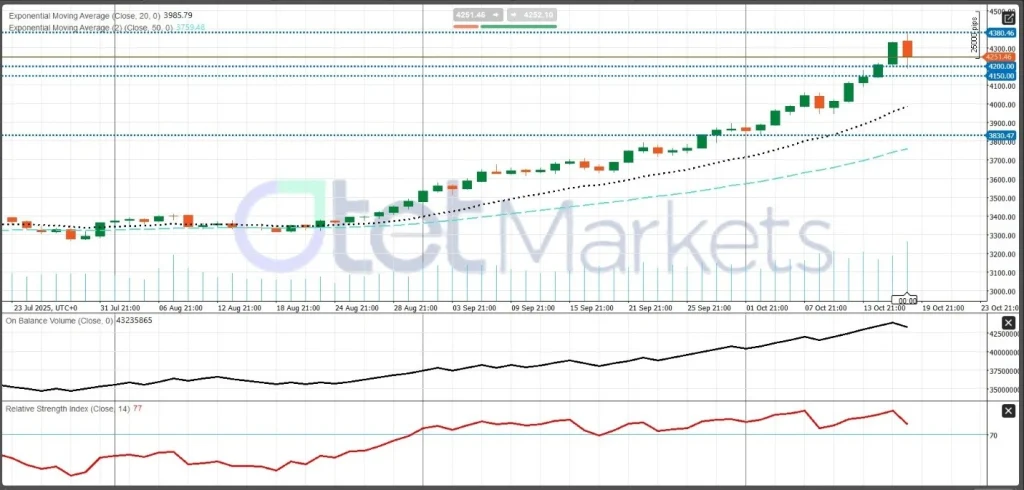
Additional Drivers
Gold remains sensitive to bond yields, dollar trends, and geopolitics. Any rebound in the U.S. 10-year yield or DXY could cause quick pullbacks, though the medium-term outlook for the dollar remains weak, offering a favorable environment. Heightened geopolitical risk — from U.S.–China tensions to Middle East instability — continues to strengthen gold’s safe-haven appeal.
Energy Market Review & WTI Outlook — Week Ahead
Crude oil prices closed lower last week as bearish fundamentals overshadowed macroeconomic support. WTI crude settled around $57.70 per barrel, down nearly 3% week-on-week, while Brent ended near $61 per barrel. The pullback reflected rising U.S. inventories, seasonal refinery maintenance, and a stronger U.S. dollar, all of which combined to cap upside momentum. Overall, the oil market remains locked in a $55–60 range, waiting for a clear catalyst — either from upcoming economic data or a fresh OPEC+ policy move.
Market Fundamentals and Supply Trends
According to the latest EIA report, U.S. commercial crude inventories rose by 3.5 million barrels week-on-week, marking one of the largest builds in over a month. Refinery utilization slipped to 85.7%, reflecting ongoing maintenance season, though end-user demand for refined products stayed solid. On the production side, Baker Hughes data showed 548 active rigs, including 418 oil rigs, underscoring steady upstream activity even amid weaker prices.
From a global perspective, both the EIA and IEA forecast continued inventory builds into 2026, signaling a supply-heavy market. These trends reinforce the importance of OPEC+ production discipline to avoid deeper price declines.
Key Fundamentals to Watch This Week
- U.S. Weekly Balances (API Tuesday / EIA Wednesday): Another refinery-driven crude build is expected. Gasoline and distillate figures will be critical for early signs of seasonal demand recovery.
- U.S. Production & Rig Count (Friday): Stability above 420 oil rigs would highlight shale resilience, confirming producers’ ability to sustain operations near $55–60.
- Macro Data & USD/Real Yields (Friday): The delayed September CPI report will be the dominant macro catalyst.
- Soft CPI: Lower real yields, weaker dollar → bullish for crude.
- Hot CPI: Higher yields, firmer dollar → bearish for crude.
Global Energy Agency Outlooks
- IEA: Expects global supply to rise by 3.0 mb/d in 2025 and 2.4 mb/d in 2026, implying ongoing surplus risk.
- EIA: Projects inventories to keep building, with Brent averaging $62/bbl in Q4 2025 and $52/bbl in 2026.
- OPEC: Maintains a constructive demand view (+1.3 mb/d in 2025), emphasizing market stability via coordinated OPEC+ output control.
Technical Picture — WTI
The technical setup leans neutral-to-bearish, with momentum fading after repeated failures to break above $60 resistance.
- Resistance: $59.0–60.0 (supply zone); a breakout could target $61.5.
- Support: $56.0–56.5 (recent lows), then $55.0 (psychological floor).
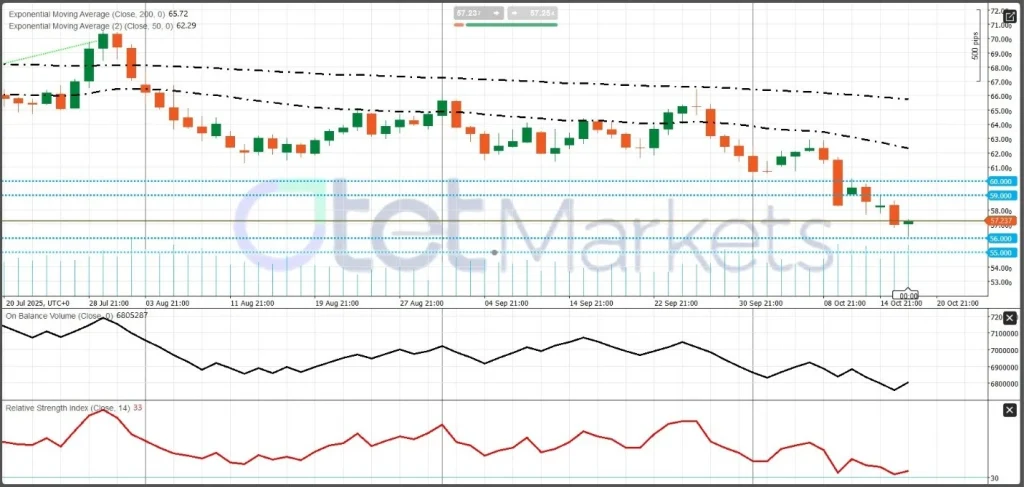
Crypto Market — Current State & Weekly Economic Outlook
The broader crypto market remains in an uptrend, though short-term momentum has turned choppy after the early-October rally. Bitcoin (BTC) continues to dominate, with rising market share indicating that investors prefer large-cap coins over riskier altcoins. The market structure remains constructive, but increasingly data dependent as macro uncertainty builds.
Market Overview
Derivatives data show mixed sentiment. Funding rates are still positive but have eased from recent highs, while futures basis remains healthy — a setup that supports dip-buying but also leaves room for rapid liquidations on negative macro surprises. Stablecoin supply continues to expand, providing a key source of spot-market liquidity, while ETF and ETP flows remain the dominant driver of Bitcoin’s price direction. Sustained inflows act as a price floor, while outflows quickly heighten volatility.
On-chain activity remains stable: transaction fees, Layer-2 throughput, and active addresses all indicate a steady network environment. Miner and validator selling pressure remains limited but tends to rise during strong rallies as profits are realized.
Crypto-Native Catalysts to Watch
While U.S. CPI and PMI releases will influence global risk appetite, several crypto-native factors will steer intraday sentiment:
- BTC ETFs: Daily flow data are the most important near-term indicator. Sustained inflows reinforce bullish momentum.
- Ethereum (ETH): Investors are watching post-Dencun upgrade performance, staking inflows, and roadmap updates.
- Altcoin Sectors:
- Layer-2s/Rollups: Rising sequencer revenue and TVL growth drive sector rotation.
- DeFi: Stablecoin velocity and DEX volumes are key; risk-on sentiment triggers renewed activity.
- AI & Gaming Tokens: Still speculative and headline-driven, best treated as short-term plays.
Technical Landscape — Bitcoin (BTC)
- Support: $104,000–105,000 — recent breakout zone and a critical defense line.
- Resistance: $108,000 (50-day EMA) and $110,000 (100-day EMA). A daily close above $110K could extend the uptrend.
Momentum is positive, but short-term overbought signals suggest a likely consolidation phase between $104K–$110K before the next major move.
Risks and Macro Triggers
Potential headwinds include hot inflation data, which could lift the USD and weigh on valuations; ETF outflows or stablecoin contraction, which could reduce liquidity; and regulatory or technical shocks (bridge or Layer-2 incidents) that may spark isolated selloffs.
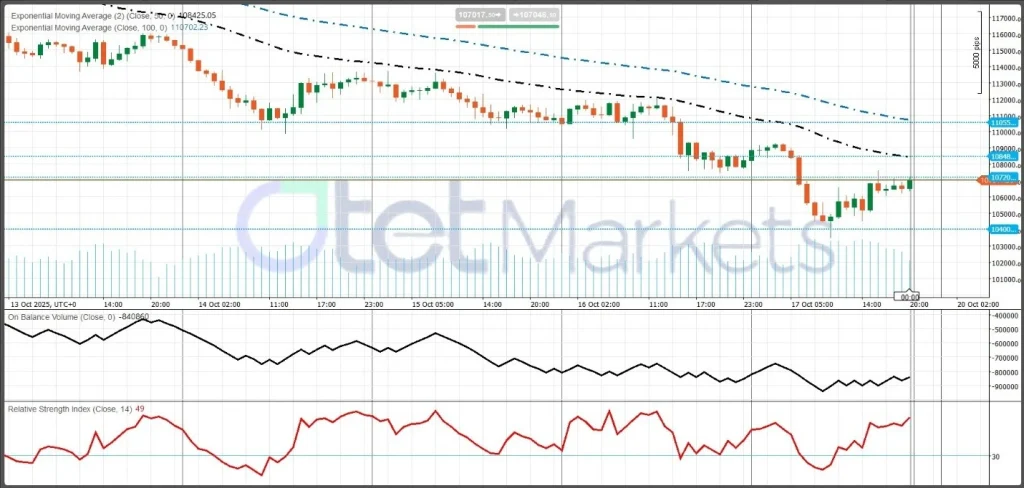
Bottom Line
Crypto remains a macro-sensitive growth asset this week. If U.S. inflation data cool and the dollar weaken, expect BTC to lead gains with selective follow-through from strong altcoins. A hot CPI, however, would likely push the market back into a defensive BTC-led range. Traders should stay disciplined, watch ETF and stablecoin flows, and let the macro data dictate the next trend in this cautiously bullish market.
Share
Hot topics

Best Forex Trading Hours for Iranian Traders
The Forex market operates 24-hours a day, but clearly not every hour, equal it could even be every trading session, is profitable. There are times when the market sleeps, is...
Read more

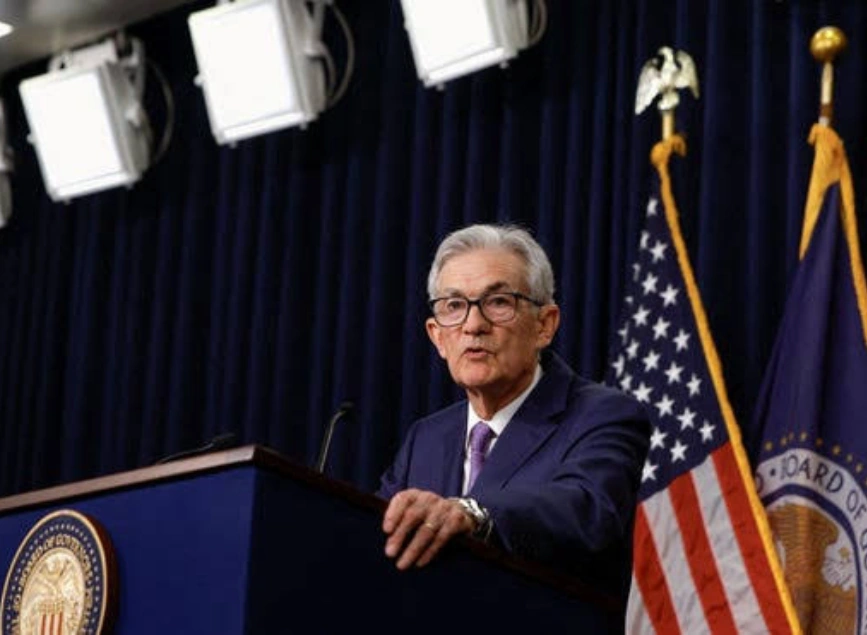

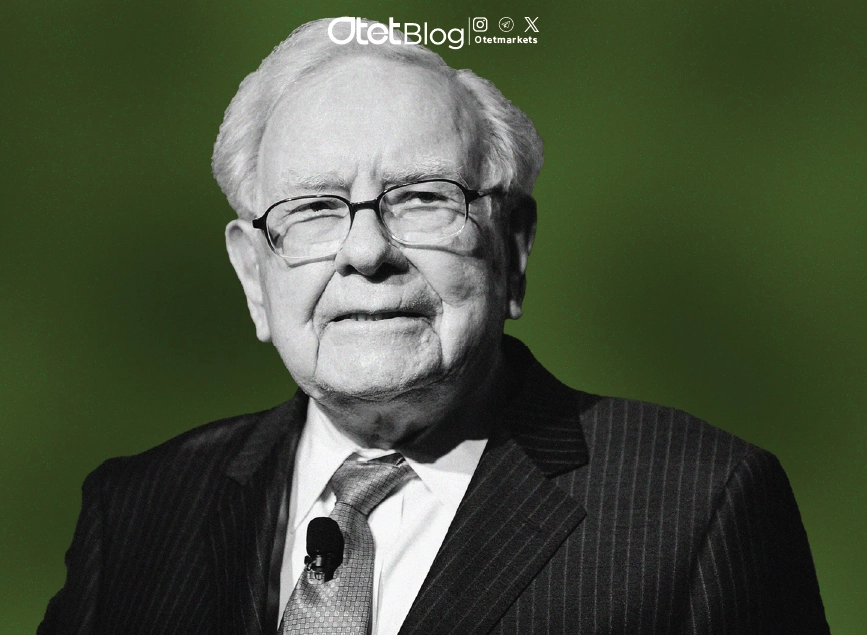
Submit comment
Your email address will not be published. Required fields are marked *